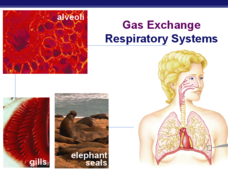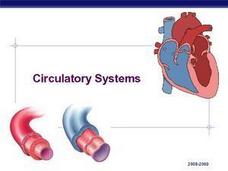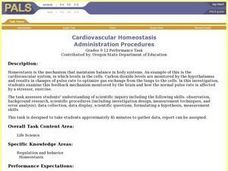Curated OER
Gas exchange: Respiratory Systems
The need for a respiratory system in humans versus being reliant on gas exchange structures is demonstrated. There are many details about the advantages and disadvantages of each mechanism. Students are able to learn about the...
Curated OER
Gas Exchange And Respiratory Systems.
Explore structures within the realm of gas exchange in terrestrial and aquatic life. The excellent, labelled diagrams and clear descriptions help your students view the different structures and adaptations that have...
Curated OER
Circulatory Systems
A slideshow that covers the all-important details related to basic human circulation. The reasoning for exchange of material methods is presented and then labeled diagrams of the main human transfer systems are shown, along with...
Nuffield Foundation
Measuring Rate of Water Uptake by a Plant Shoot Using a Potometer
How quickly does a plant transpire? Learners explore this question through measuring water uptake with a potometer. They time the movement of a bubble a set distance to understand the motion and rate of speed.
Serendip
Diffusion and Cell Size and Shape
Is your class ready to size up the topic of diffusion? Help them get cell shape savvy with a well-written handout. The resource covers how substances such as oxygen passively move through the cell membrane and how cell size and shape...
Serendip
Photosynthesis Investigation
Can scientists increase the rate of photosynthesis to help clean the air? Scholars complete an experiment determining net photosynthesis. Then, they apply knowledge from the activity to design their own investigations of the factors that...
Curated OER
Using Ion Exchange Chromatography to Separate Proteins
Young scholars explore protein purification by separating a positively charged molecule, lysozyme, from a negatively charged molecule, albumin, at neutral pH using ion exchange chromatography.
Curated OER
Estimating Maximum Cell Sizes
In this estimating cell sizes activity, students read about the relationship between a cell's size and the rate of cell waste diffusion. Students solve 4 problems including writing the equation for the rate of waste exchange, finding the...
Nuffield Foundation
Measuring Respiratory Quotient
How do scientists prove tiny living things respire? Young scientists build a respirometer and measure respiration rates in living creatures. By comparing the measurements of both plants and animals, they understand the similarities.
Curated OER
The Spread of Aids
This is an effective simulation of how communicable diseases such as AIDS can be spread throughout a population. Classmates exchange samples from their individual cups of liquid: one of them containing a dilute NaOH solution, and the...
Curated OER
Cardiovascular Homeostasis
Students develop and conduct an experiment to answer the question," How does cardiovascular exercise affect the pulse rate?". They record the changes to heart rate during different levels of exercise.
Serendip
Should States Repeal Their Laws Banning First Cousin Marriage?
Around half of the states in the US ban first cousin marriage, but does science support that ban? Scholars work through genetic analysis of the risks to understand if more states should ban the practice—or if some should remove it. They...
Curated OER
Diffusion through Membranes
Students identify diffusion and its processes through experimentation and calculations. They also use a CBL and conductivity probe to measure the conductivity of various solutions and study the effect of concentration gradients on the...
Curated OER
Latin America and the Caribbean in the Classroom: The Economy and Trade
Students use the internet to gather information on daily exchange rates. They calculate the exchange rates between two countries by role playing they are going on vacation to these destinations.
Nuffield Foundation
Effect of Size on Uptake by Diffusion
Cell size is limited by the surface area to volume ratio, but why is this true? Scholars measure the surface area and volume of cubes before placing them into liquid. After a set amount of time, they measure the uptake by diffusion for...
Curated OER
Mixtures
Students experiment with solutions. In this mixtures and solutions science lesson, students work in groups of three to perform an experiment. Students place a sugar cube in three glasses, and observe and record the different rates...
Curated OER
Animal Skin
Students investigate the skin surface to body area ratios for different animals. In this seventh/eighth grade mathematics/science instructional activity, students explore heat transfer between an animal’s body and the...
Curated OER
Bubonic Plague
Students study the history of the causes and spread of the Bubonic Plague. They determine what groups of people were affected by the disease and locate the geographic areas they resided in. Working in small groups they conduct a an...
Curated OER
Nutrition
In this nutrition worksheet, students describe what nutrient is and how the energy it has is measured. Then they explain what is meant by interconversion of molecules. Students also list the common vitamins and mineral required by the...
Curated OER
Hot Rocks
Students demonstrate that setting of plaster and cement is a change, which involves a release of heat energy, use data collected experimentally to construct comparison graphs and analyze the graphs to make predictions about future...
Curated OER
Respiration
Students study the gas exchanges that occur during cellular respiration. They observe what happens as a result of a number of variables on the rate of respiration. They use microrespirometers to measure the oxygen consumption of...
Curated OER
Mountain Building
Fourth graders identify variables that influence rates of change. They, through group consensus and using the assigned materials, design and build what they believe to be the strongest mountain possible.
Curated OER
How Does Human Respiration Relate to Radon?
Students examine the role of human respiration and how it relates to radon. They identify damage to the lung from the exchange of carbon dioxide and oxygen. They work together to complete a lab activity and worksheet.
Serendip
Understanding the Biology of Cancer
After initial exposure to a carcinogen, a cancer diagnosis often takes more than a decade due to the slow buildup of mutated cells in the body. Scholars learn about the biology of cancer with a worksheet and discussion questions. They...
Other popular searches
- Currency Exchange Rates
- Math, Exchange Rates
- Math Exchange Rates
- Foreign Exchange Rates
- Math Lesson Exchange Rates
- Algebra Exchange Rate
- Calculating Exchange Rates
- Currany Exchange Rates
- Curran Exchange Rates
- Exchange Rate Changes
- Current Exchange Rate
- International Exchange Rate























